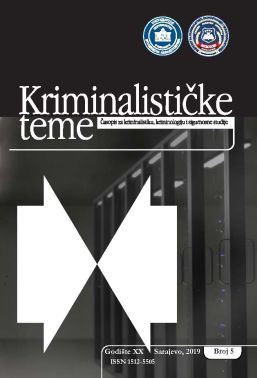KORIŠTENJE ELEKTRONSKOG I KORESPONDENTNOG BANKARSTVA ZA AKTIVNOSTI PRANJA NOVCA
USE OF ELECTRONIC AND CORRESPONDENT BANKING FOR MONEY LAUNDERING ACTIVITIES
Author(s): Ajla ŠurkovićSubject(s): Criminal Law, Criminology, ICT Information and Communications Technologies
Published by: Fakultet za kriminalistiku, kriminologiju i sigurnosne studije Univerziteta u Sarajevu
Keywords: money laundering; electronic banking; correspondent banking; shell banks;
Summary/Abstract: Inspiration for the research and problem (s) referred to in this work: Progress in development of informational technologies has affected the emergence of new forms of money laundering that is characterized by sophistication, concealment, higher level of organisation, international character as well as the creativity of criminals. Electronic transfers of money from one back account to another and the speed of its realization, allows a cover-up of the true money source. Research goals (scientific and/or social): Scientific goal reflects itself in the description of factors that affect the emergence of money laundering within electronic and correspondent banking. Social goal refers to the informing of academic and expert public regarding specifics of money laundering using electronic and correspondent banking. Methodology/Design: During the execution of this work, literature of regional and foreign authors will be used as well as other scientific articles and articles of expertise available on internet sites. In said work following methods will be used: method of analysis, and deductive and inductive method. Regarding the data collecting method, content analysis will be used. Limitations in the research/work: The limitation of this particular work lies in the theoretical deliberation of money laundering through electronic and corresponding banking. More specifically, through said deliberation, existing scientific findings in reference to the subject of research will be presented. Therefore in this work, it is not possible to address practical solutions that would affect prevention of money laundering within areas included in this research. Results/Findings: Although it includes three traditional phases, money laundering through the use of electronic and correspondent banking has certain specifics in regards to the place and the way certain activities are done. Internet Banking and Mobile Banking as channels for electronic banking distribution can allow for concealment of origin of funds as well as the identity of clients, increasing the risk of money laundering. On the other hand, correspondent banking is being used for money laundering activities because it presents a form of business relationship that allows for commerce with the residential bank without precise and reliable information about the origin of the funds. Especially risky are correspondent relations with "shell" banks that physically do not exist in any country, as well as establishment of "off-shore" centers that provides certain legal and physical persons with certain "financial benefits".
Journal: Kriminalističke teme – Časopis za kriminalistiku, kriminologiju i sigurnosne studije
- Issue Year: XIX/2019
- Issue No: 5
- Page Range: 483-497
- Page Count: 15
- Language: Bosnian, Croatian, Serbian

